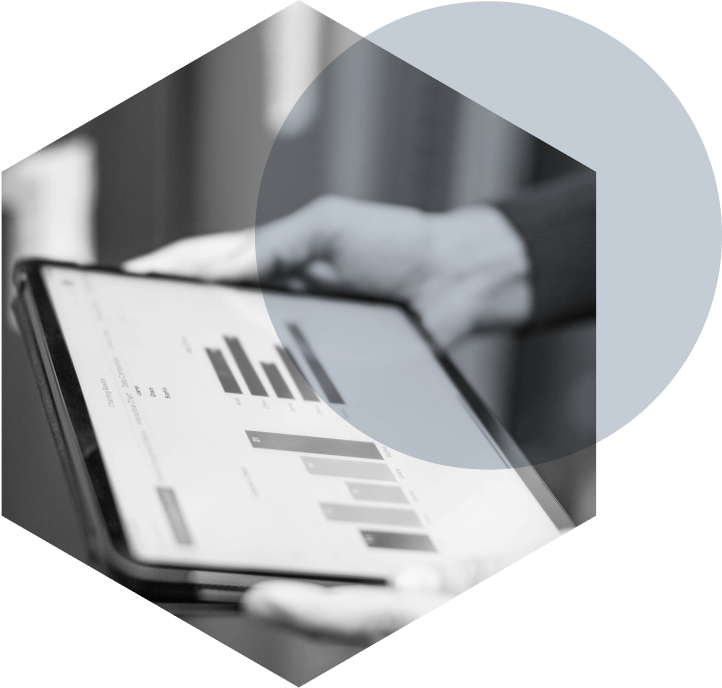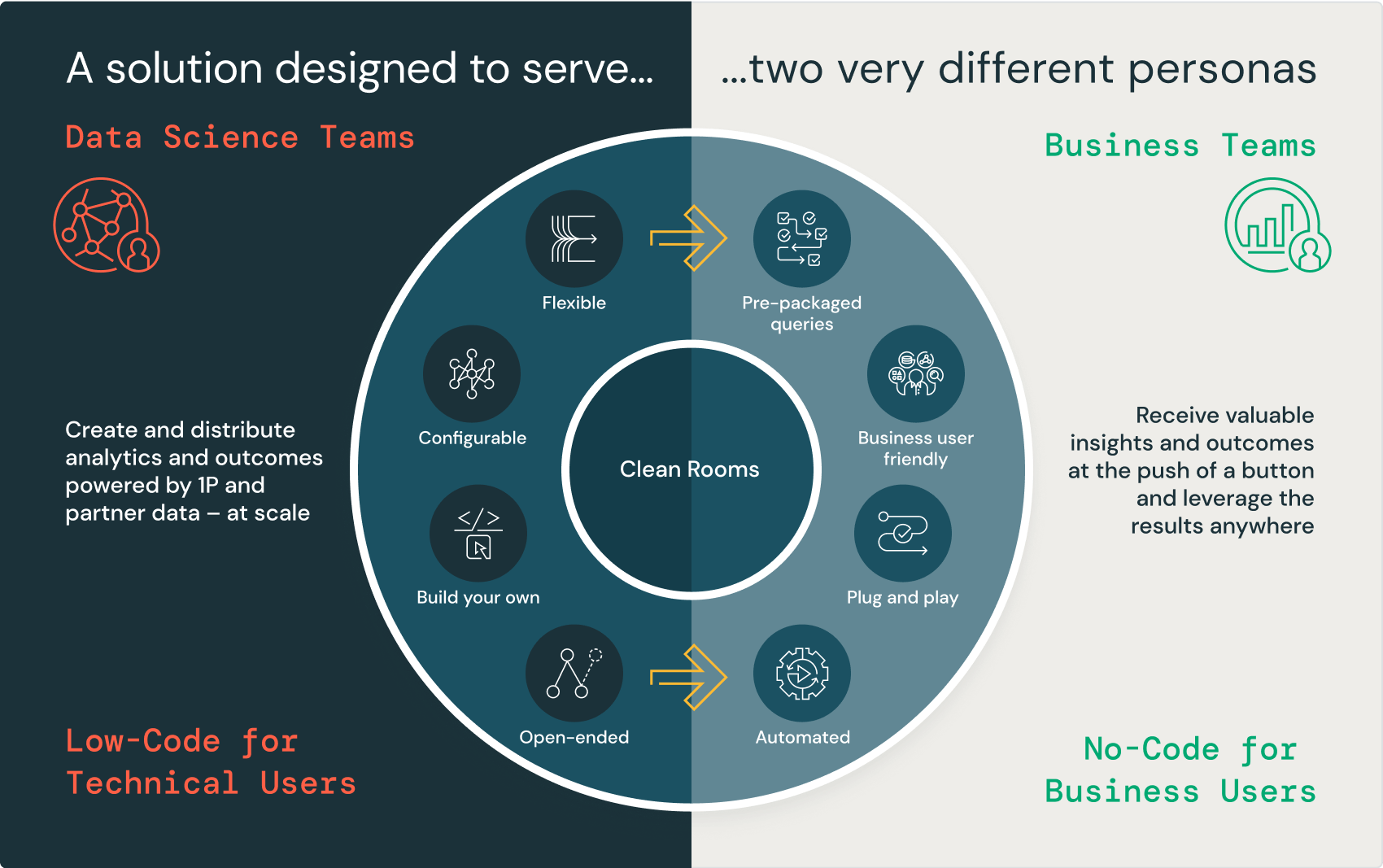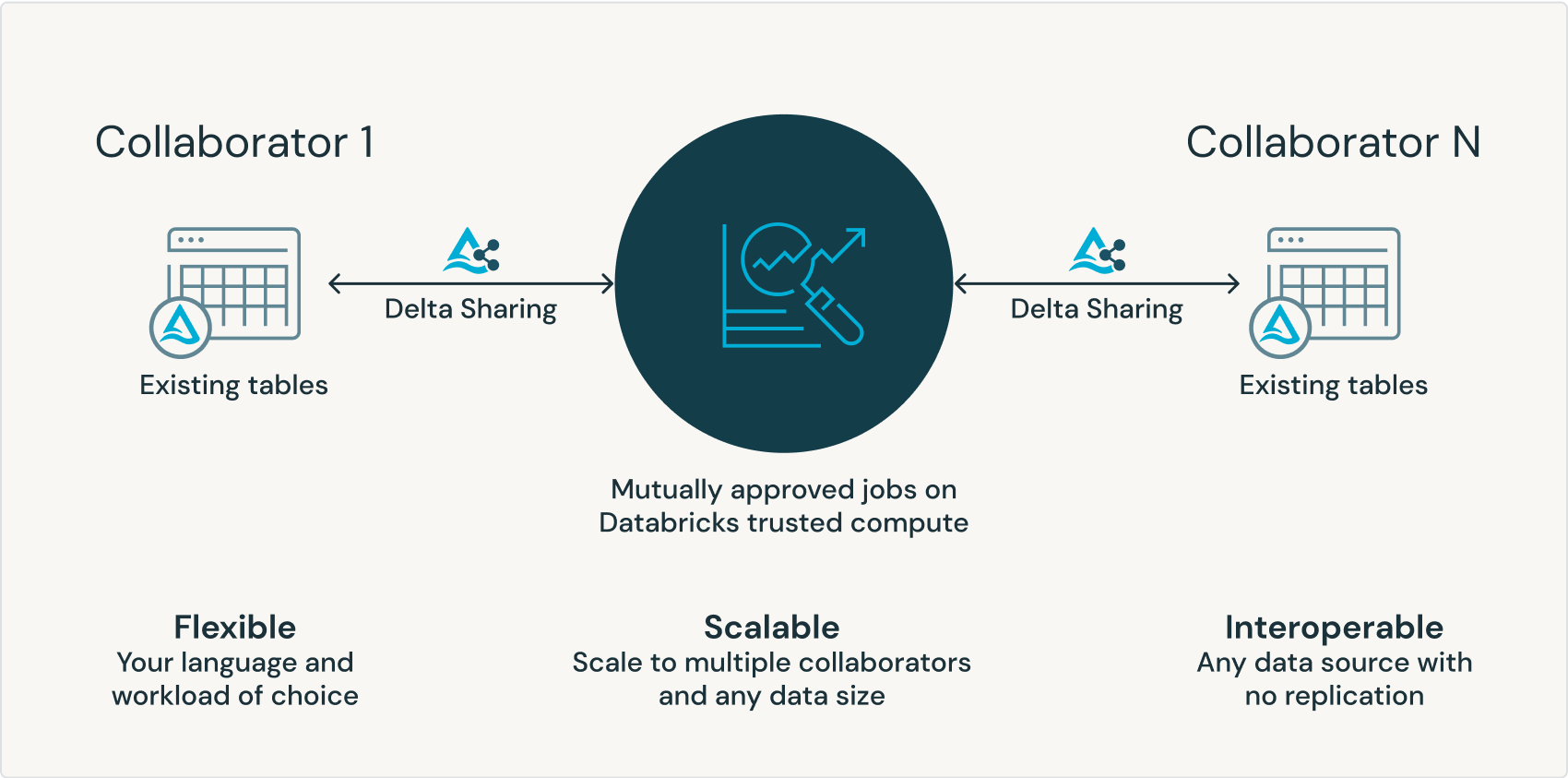Data Clean Rooms
Leverage secure data collaboration to maximize insights and performance

Whether you are a marketer seeking to optimize your campaigns, a data scientist looking for a secure environment in which to experiment, or an IT professional aiming to champion better data management strategies, the following article will dive into secure data collaboration and analysis, exploring the benefits, challenges and best practices associated with data clean rooms.
Note: Throughout this article, we use terms like "customer," "audience" and "member" interchangeably. They represent the end user, and are typically specific to an industry (e.g., "customer" in retail, "audience" in media and entertainment, "member" in banking). When you see the term "customer," it is equally relevant to think "audience" or "member" based on your industry and specific use cases.
What Are Data Clean Rooms?
Data clean rooms allow businesses to easily collaborate on data in a secure environment, where multiple parties can safely combine sensitive data without compromising privacy or security. By implementing stringent protocols and advanced technologies, data clean rooms enable organizations to share data securely while ensuring compliance with privacy and regulatory requirements.
Why Are Data Clean Rooms Important?
In an era where data breaches and privacy concerns are prevalent, businesses must adopt robust measures to protect sensitive information. Data clean rooms address these challenges by offering a secure ecosystem for data analysis, ensuring the confidentiality and integrity of the data involved. They empower organizations to collaborate and extract valuable insights from shared data without the risk of data leakage or unauthorized access.
When properly architected, data clean rooms enable the ability to:
Key Features of a Data Clean Room:
Data clean rooms incorporate several essential features that enable secure and effective data collaboration. These features may include:
- Data segregation and isolation: Data clean rooms employ an isolated environment to combine data from multiple parties while preventing unauthorized access or inadvertent data leakage. Access controls and permission levels are enforced to maintain the confidentiality and integrity of the data.
- Secure data collaboration: Data clean rooms provide a secure framework for exchanging data among authorized parties. Robust encryption protocols, secure file transfer mechanisms and secure APIs are employed to protect data in transit and at rest.
- Access controls and audit trails: Access controls within data clean rooms ensure that only authorized individuals or entities can access specific data sets. Additionally, comprehensive audit trails track user activities, providing visibility and accountability for data interactions.
- Anonymization and de-identification: Data clean rooms may offer built-in capabilities for anonymization and de-identification of sensitive data. These techniques help protect privacy by removing personally identifiable information while still enabling meaningful analysis.
- Compliance frameworks: Data clean rooms are designed with compliance in mind. They often align with relevant regulatory frameworks, such as GDPR, HIPAA or CCPA, to ensure that data handling and collaboration practices adhere to legal and industry-specific requirements.

Types of Data Clean Rooms
There are two primary options for data clean rooms, a platform-managed clean room and an orchestrator clean room, each serving unique purposes in facilitating secure data collaboration. While the concept of data clean rooms has been around for some time, advancements have led to the emergence of different types to meet specific needs. These types offer improved advertising performance, data analysis and activation across the advertising ecosystem. Let's explore:
Platform-managed data clean rooms:
Traditionally, walled gardens have employed data clean rooms to enable data collaboration between advertisers and their platforms. These clean rooms have demonstrated effectiveness in improving advertising performance by addressing issues like frequency capping and audience suppression. They aim to prevent overserving ads to the same individuals or households. With the expanding range of channels, robust measurement and attribution capabilities are essential for optimizing advertising spend.
Orchestrator data clean rooms:
Alongside platform-managed data clean rooms, orchestrators are neutral third parties that span clouds, regions and data platforms. These neutral clean rooms not only organize, analyze and measure data but also facilitate activation across the entire advertising ecosystem. They enable strong planning, activation and measurement of marketing spend.
By leveraging the appropriate data clean room solution, you can harness the power of secure data collaboration, uncover valuable insights and drive tangible value for your business.
Why Marketers Should Love Using Data Clean Rooms:
- Improve Marketing Effectiveness:
In today's data-driven marketing landscape, accessing comprehensive and reliable campaign data is crucial to maximizing return on ad spend (ROAS). Data clean rooms provide marketers with a solution to overcome data deprecation and signal losses. By leveraging attribution models that combine transaction data with ad performance metrics like impressions and clicks, marketers gain granular insights into the sources of conversions. This empowers them to analyze campaign reach, frequency and engagement, optimizing media performance and minimizing ad fatigue as they navigate a fragmented media landscape. - Data Insights for Building High-Quality Audiences:
Acquiring user-level data has become challenging due to privacy regulations and changes implemented by platforms like Apple and Google. However, data clean rooms offer marketers the ability to collaborate with trusted partners and enrich their data, enabling the creation of highly targeted and effective look-alike models. Marketers can leverage this data to segment audiences based on consumer behavior, purchase history and other relevant criteria. By delivering more personalized and relevant messages through the most effective channels, marketers can enhance audience engagement and drive better marketing outcomes. - First-Party Data Partnerships for Unleashing New Possibilities:
Data clean rooms foster secure and permission-based environments that facilitate first-party data partnerships. Marketers can leverage these partnerships to propel their brands in ways that were previously impossible. By collaborating with other organizations in a data clean room, marketers gain valuable insights and data sets that help them understand their target categories better. This partnership benefits not only marketing but also other teams within the organization, including product development and customer service. The synergy between different teams and data sets enables a holistic approach to business growth and innovation.
Embracing data clean rooms empowers marketers to access and leverage more comprehensive data, unlock valuable audience insights, and forge impactful partnerships within a safe and permission-based environment. By harnessing the potential of data clean rooms, marketers can elevate their marketing strategies, enhance customer experiences and drive sustainable business growth.
The Critical Role of Data Clean Rooms in the Broader Data Strategy
Despite the value added to marketing departments, when clean room products are adopted without involving IT, several risks can arise. First, there is a higher chance of data security breaches and noncompliance with regulations, as the marketing team may not have a comprehensive understanding of necessary security measures and compliance requirements. Additionally, without IT involvement, integrating the clean room product into existing IT systems and data management processes becomes challenging, leading to data silos and inconsistencies. The marketing team may also face difficulties in efficiently managing data, including data cleansing and transformation, resulting in poor data quality and limited value derived from the clean room solution. In addition, technical support, updates and maintenance may be compromised without IT's involvement, leading to delays and system downtime.
To address these risks, close collaboration between the marketing team and IT is essential. IT's expertise ensures proper implementation of security controls, compliance measures and integration with existing systems. They also play a crucial role in data management practices, including data cleansing and data quality, ensuring that the clean room solution operates effectively. IT's involvement guarantees technical support, maintenance and scalability of the clean room solution, preventing potential disruptions and enabling seamless integration with other business systems. This enables IT to establish data ownership and access controls, safeguarding data privacy and security within the clean room environment.
By involving IT in the adoption of a clean room product, the marketing team can mitigate risks, ensure data security and compliance, improve data management practices, and receive necessary technical support. This collaboration creates a strong foundation for the successful implementation and utilization of the clean room solution, maximizing its benefits for the organization as a whole.
Challenges of a Data Clean Room
While data clean rooms offer numerous benefits, their implementation and operation are not without challenges. Understanding these challenges is crucial for teams looking to establish and maintain data clean rooms effectively. Let's explore some common hurdles:
- Data governance and compliance: Ensuring data governance and compliance can be a complex undertaking. Organizations must navigate various regulatory requirements, industry standards and internal policies to meet compliance obligations within the data clean room environment.
- Data integration and compatibility: Integrating diverse data sets from different sources into the data clean room can present compatibility issues. Data sets may have varying formats, structures or data quality standards, requiring careful consideration and data preparation efforts for effective integration.
- Access control and permissions: Establishing granular access controls and permission levels within the data clean room can be challenging. Striking a balance between providing authorized users with the necessary access rights and preventing unauthorized access is crucial for maintaining data security and privacy.
- Data anonymization and de-identification: Anonymizing or de-identifying sensitive data while retaining its usefulness for analysis can be a delicate task. Organizations need to implement robust techniques and algorithms to safeguard personal information adequately, ensuring privacy while maintaining data utility.
- Technical infrastructure and scalability: Implementing and managing the technical infrastructure required for data clean rooms can be complex and resource-intensive. Ensuring the scalability, performance and availability of the infrastructure to handle increasing volumes of data and user interactions is crucial for optimal operations.
- Data quality and consistency: Data quality and consistency are vital for accurate analysis and reliable insights. Ensuring that the data within the data clean room is of high quality, and is free from errors, inconsistencies and biases, requires effective data validation, cleansing and normalization processes.
- User training and adoption: Introducing data clean rooms to teams and ensuring their adoption can be a challenge. Proper training and education initiatives are necessary to familiarize users with the functionalities, benefits and best practices associated with data clean rooms.
- Data lifecycle management: Effectively managing the lifecycle of data within the data clean room can be complex. Establishing policies and procedures for data ingestion, retention, archiving and secure disposal is crucial for maintaining data integrity and compliance throughout its lifecycle.
Addressing these challenges requires careful planning, collaboration and a proactive approach. By understanding and anticipating these obstacles, organizations can implement effective strategies and solutions to overcome them, ensuring the successful implementation and operation of data clean rooms.
How Databricks Clean Rooms Solves These Challenges
Databricks Clean Rooms allows businesses to easily collaborate in a secure environment with their customers and partners on any cloud in a privacy-safe way.
Flexible — your language and workload of choice: Databricks Clean Rooms empowers collaborators to share and join their existing data, and run complex workloads in any language — Python, R, SQL, Java and Scala — on the data while maintaining data privacy. Beyond traditional SQL, users can run arbitrary workloads and languages, allowing them to train machine learning models, perform inference, and utilize open source or third-party privacy-enhancing technologies. This flexibility enables data scientists and analysts to achieve more comprehensive and advanced data analysis within the secure clean room environment.
Scalable, multiparty collaboration: With Databricks Clean Rooms, you can launch a clean room and work with multiple collaborators at a time. This capability enables real-time collaboration, fostering efficient and rapid results. Moreover, Databricks Clean Rooms seamlessly integrates with identity service providers, allowing users to leverage offerings from these providers during collaboration. The ability to collaborate with multiple parties and leverage identity services enhances the overall data collaboration experience within Databricks Clean Rooms.
Interoperable — any data source with no replication: Databricks Clean Rooms excels in interoperability, ensuring smooth collaboration across diverse environments. With Delta Sharing, collaborators can seamlessly work together across different cloud providers, regions and even data platforms without the need for extensive data movement. This eliminates data silos and enables organizations to leverage existing infrastructure and data ecosystems while maintaining the utmost security and compliance.

Clean Room Best Practices
Here are some best practices to consider when setting up and implementing a data clean room:
- Define clear objectives and use cases: Before setting up a data clean room, clearly define your objectives and use cases. Identify the specific data collaboration and analysis goals you want to achieve. This will help you design and configure the data clean room to align with your specific requirements.
- Data classification and segmentation: Classify and segment your data based on sensitivity levels, access requirements and compliance considerations. Categorize data into tiers, such as highly sensitive, moderately sensitive and nonsensitive, to establish appropriate access controls and data handling protocols within the data clean room.
- Robust security measures: Implement robust security measures to protect the data clean room and the sensitive data it houses. This includes employing encryption, access controls, secure authentication mechanisms and intrusion detection systems. Regularly update and patch security systems to stay protected against evolving threats.
- Data anonymization and privacy: Implement proper data anonymization and privacy techniques to protect sensitive information within the data clean room. Ensure that personally identifiable information (PII) is adequately anonymized or de-identified, reducing the risk of privacy breaches while maintaining data utility for analysis.
- Strong access controls: Establish granular access controls and permissions within the data clean room. Assign appropriate roles and privileges to users based on their responsibilities and data needs. Regularly review and update access rights to maintain data confidentiality and prevent unauthorized access.
- Compliance with regulations: Ensure that the data clean room complies with relevant regulations and industry standards, such as GDPR, HIPAA or CCPA. Stay informed about changes to regulations and update your practices accordingly to maintain compliance.
- Data governance and documentation: Establish robust data governance practices within the data clean room. Clearly define data ownership, data handling procedures and data lifecycle management processes. Document these practices and ensure they are readily accessible to users within the data clean room.
- User education and training: Provide comprehensive education and training to users of the data clean room. Ensure that they understand the purpose, functionalities and best practices associated with the data clean room. Regularly update training materials to address new features or changes in the environment.
- Regular auditing and monitoring: Implement regular auditing and monitoring processes to detect any suspicious activities or potential security breaches. Monitor user access, data usage patterns and system logs to identify anomalies. Conduct periodic security assessments to evaluate the effectiveness of implemented security measures.
- Continuous improvement: Continuously review and improve the data clean room setup and operations. Stay informed about emerging technologies, industry best practices and new security threats to adapt your approach accordingly. Regularly gather feedback from users and stakeholders to identify areas for enhancement and implement iterative improvements.